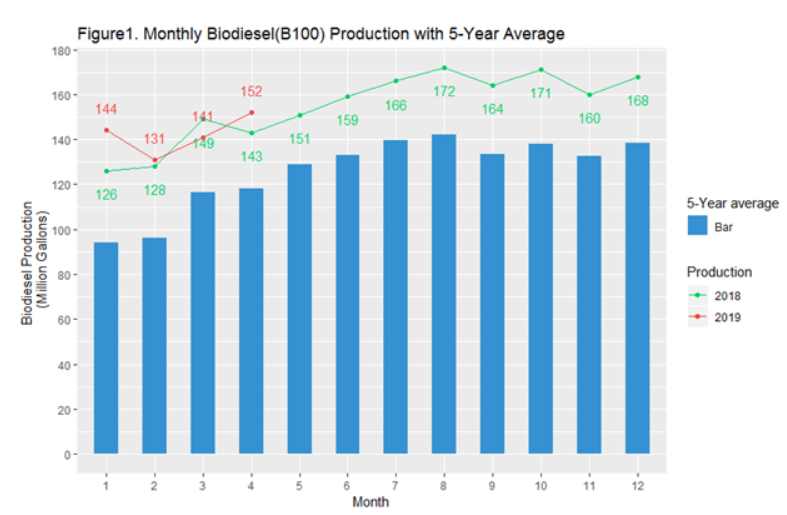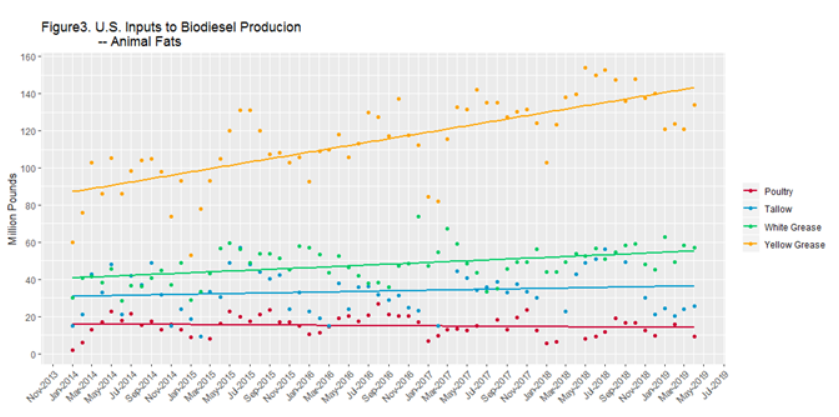The US Energy Information Administration (EIA) published Monthly Biodiesel Production Report on June 28th. In this article, we will conduct a descriptive analysis of pure biodiesel (B100) production and its feedstocks usage back to 2014. EIA reported 152 million gallons pure biodiesel was produced in this April, which was 11 million gallons more compared with March 2019, and 9 million gallons more compared with April 2018. In figure1, the red line with dots represents the pure biodiesel production in 2019. The green line with dots represents the pure biodiesel production in 2018. The blue bars represent the 5-year average (2014 to 2018) biodiesel production for each month. This April’s production is 33.8 million gallons more compared with April’s 5-year average production. Both 2018 and 2019 biodiesel productions are higher than the 5-year average level. The 152 million gallon production is the highest April record surpassing 2018 April production. Also, due to seasonality, we could expect an increasing trend within the next few months.

Figure 2 shows the monthly usage of vegetable oils, i.e., canola oil (represented by red color), corn oil (green color) and soybean oil (blue color), in biodiesel (B100) production from January 2014 to April 2019. Some data records for canola oil are missing because EIA withheld them to avoid disclosure of individual company data. Soybean oil remains the largest vegetable oil input for the entire study period. In April 2019, soybean oil input was 631.84 million pounds to biodiesel production (54.48% of total feedstock input), 14.83 million pounds over 2019 March input. Canola oil input was 120.72 million pounds to biodiesel production (10.43% of total feedstock input), 37.61 million pounds over 2019 March input. Corn oil input was 154.05 million pounds (13.28% of total feedstock input), 13.37 million pounds over previous month input.
Moreover, we applied simple liner regression models on vegetable oil inputs. With time moving forward, we observe a significant increasing trend for soybean oil input over time, shown as the blue equation in Figure 2, and a significant increasing for corn oil input, shown as the green equation, but not for canola oil input.

Figure 3 shows the monthly usage of animal fats and recycled feeds, i.e., poultry fat(represented by red color), tallow (blue color), white grease (green color, also called choice white grease) and yellow grease (yellow color), in biodiesel (B100) production within the same study period. Again, some data records for poultry fat and tallow are missing, because EIA withheld them to avoid disclosure of individual company data.
Yellow grease occupied the top share of animal fats and recycled feeds input to U.S. biodiesel production from 2014 January to 2019 April. Yellow grease usage increased to 133.91 million pounds in April 2019, up 12.97 million pounds from March. It declined 5.62 million pounds from the year-ago level. Tallow input increased 1.94 million pounds to 25.88 million pounds from March 2019 but dropped 17.05 million pounds compared to the year-ago level. White grease input decreased from 58.48 million pounds in March to 57.04 million pounds in April 2019 but remained 3.04 million pounds above the year-ago level. For poultry fat, due to withheld data by EIA, we don’t have the poultry fat input number for March 2019. It decreased from 16 million pounds in February 2019 to 9.27 million pounds in April 2019.
Animal fats and recycled feeds usage captured 21.8% of total feedstock usage in April 2019, which are yellow grease 11.55%, following by white grease 4.91%, tallow 2.24%, poultry fat 0.79% and others 2.32%. The animal fats and recycled feedstock usage declined 0.6% from April 2018, with unknown poultry fat input.

With the expected increasing of biodiesel production for the next couple months, the soybean oil and yellow grease will continue to be the top two inputs from feedstocks usage. Corn oil will increase the input amount to biodiesel production too. However, since we didn’t observe a significant increasing trend on canola oil, poultry fat, tallow, and white grease, those items may slightly increase, number wise, but maintain at the same level.

